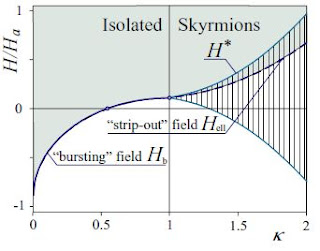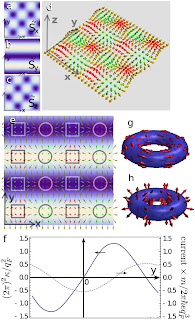Here is a collection of articles on skyrmions in magnets, an increasingly hot topic:
1) Spontaneous skyrmion ground states in magnetic metals.
U. K. Rö ler, A. N. Bogdanov and C. Pfleiderer
Nature 442, 797 (2006)
ler, A. N. Bogdanov and C. Pfleiderer
Nature 442, 797 (2006)
 |
Three chiral modulated structures for noncentrosymmetric ferromagnets and comparison of their energy density.
|
2) Spin chirality on a two-dimensional frustrated lattice.
Daniel Grohol, Kittiwit Matan, Jin-Hyung Cho, Seung-Hun Lee, Jeffrey W. Lynn, Daniel G. Nocera and Young S. Lee
Nature Materials 4, 323 (2005)
 |
| Measurements of the field-induced transition to a state with non-zero scalar chirality. |
3) Skyrmion lattice in a two-dimensional chiral magnet.
Jung Hoon Han, Jiadong Zang, Zhihua Yang, Jin-Hong Park, and Naoto Nagaosa
Phys. Rev. B 82, 094429 (2010)
 |
| (a) A typical Skyrme-crystal spin configuration given by Eq. 19 with B=D2 /J, with the optimized lattice spacing lH= 3/ 2. (b) Skyrme-crystal spin configuration obtained by Monte Carlo method from the lattice spin model |
4) Skyrmions and anomalous Hall effect in a Dzyaloshinskii-Moriya spiral magnet.
Su Do Yi, Shigeki Onoda, Naoto Nagaosa, and Jung Hoon Han
Phys. Rev. B 80, 054416 (2009)
 |
A plot of the spin configuration projected on the xy plane Si x ,Si y in the three spin crystal ground states: a SC1 at A2 ,H = 2.0, 0.0 , b SC2 at A2 ,H = 3.0, 0.0 , and cSCh at A2 ,H = 0.0, 2.0 . At the bottom left of each figure are the plots of the Bragg intensity Sk 2 showing two SC1,SC2 and three SCh sets of modulation vectors. Shown at the bottom right
are the plots of the local chirality r. Bright dark regions correspond to Skyrmions anti-Skyrmions |
.
5) Condensed-matter physics: Single skyrmions spotted.
Christian Pfleiderer, Achim Rosch
Nature 465, 880 (2010) N&V
 |
| When an electron moves through a special type of magnetic texture called a skyrmion, its magnetic moment (spin) twists to adjust to the skyrmion's local spin structure (ribbon-like pattern). This twisting changes the electron's direction of travel and pushes the electron and the skyrmion in opposite directions (not shown). |
Real-space observation of a two-dimensional skyrmion crystal.
X. Z. Yu, Y. Onose, N. Kanazawa, J. H. Park, J. H. Han, Y. Matsui, N. Nagaosa, Y. Tokura
Nature 465, 09124 (2010)
 |
Topological spin textures in the helical magnet Fe0.5Co0.5Si. a, b, Helical (a) and skyrmion (b) structures predicted by Monte Carlo simulation. c, Schematic of the spin configuration in a skyrmion. d–f, The experimentally observed real-space images of the spin texture, represented by the lateral magnetization distribution as obtained by TIE analysis of the Lorentz TEM data: helical structure at zero magnetic field (d), the skyrmion crystal (SkX) structure for a weak magnetic field (50 mT) applied normal to the thin plate (e) and a magnified view of e (f). |
6) Giant Skyrmions Stabilized by Dipole-Dipole Interactions in Thin Ferromagnetic Films.
Motohiko Ezawa
Phys. Rev. Lett. 105, 197202 (2010)
 |
| (a) Illustration of a giant Skyrmion ( 1 m) in a thin ferromagnetic film. The simplest spin texture has naturally a nontrivial Pontryagin number. It can be created by applying femtosecond optical pulse irradiation focused on a micrometer spot and thus destroying the magnetic order locally. (b) Illustration of magnetic flux lines around a Skyrmion due to magnetic dipoles. When the magnetic order is destroyed locally, a new order is generated which is opposite to that of the environs, so that the magnetic flux closes by itself as short as possible. |
7) Comment to previous article.
N. S. Kiselev, A. N. Bogdanov, R. Schäfer, and U. K. Rößler
Phys. Rev. Lett. 107, 179701 (2011)
8) Spin waves in a skyrmion crystal.
Olga Petrova and Oleg Tchernyshyov
Phys. Rev. B.84. 214433 (2011)
9) Chiral skyrmions in thin magnetic films: new objects for magnetic storage technologies?
N S Kiselev, A N Bogdanov, R Schäfer and U K Rößler
J. Phys. D 44, 392001 (2011)
 |
| The magnetic phase diagram in reduced variables κ and applied magnetic field H/Ha for fixed values of Q and the reduced layer thickness l indicate the existence region of isolated skyrmions.In the double-hatched area spatially modulated phases (helicoids and skyrmion lattices) correspond to the equilibrium state of the film. |
10) Spontaneous atomic-scale magnetic skyrmion lattice in two dimensions.
Stefan Heinze, Kirsten von Bergmann, Matthias Menzel , Jens Brede , André Kubetzka, Roland Wiesendanger, Gustav Bihlmayer and Stefan Blügel
Nature Physics 7, 2045 (2011)
 |
| The nanoskyrmion lattice of the Fe ML on Ir(111). a, Sketch of the nanoskyrmion lattice: cones represent atoms of the hexagonal Fe layer and point along their magnetization directions; red and green represent up and down magnetization components, respectively. b, Atomic-resolution STM image of the pseudomorphic hexagonal Fe layer at an Ir step edge. Upper inset: The FT. Lower inset: A side view of the system (tunnel parameters UDC5 mV, ID30 nA). c, SP-STMimage of the Fe ML on Ir(111) with a magnetic tip sensitive to the out-of-plane component of magnetization (Fe-coatedWtip, BDC2 T along the tip axis, UDC50 mV, ID0:5 nA): bright (dark) spots indicate areas with magnetization parallel (antiparallel) to the tip magnetization. Left inset: Simulated SP-STMimage of the nanoskyrmion with out-of-plane magnetic tip. Right inset: FT of the experimental SP-STMimage shown in the two-dimensional Brillouin zone. |
11) ChiralityWaves in Two-Dimensional Magnets.
D. Solenov, D. Mozyrsky, and I. Martin
Phys. Rev. Lett. 108,096403 (2012)
 |
| (a-e) The optimal magnetic state S(r)=(sinKy cosKx, cosKy, sinKy sinKx) realized at small Kondo coupling, J= 1. Panels (a)-(c) show the spatial dependence of the three magnetization components. (d) Full 3D magnetization pattern. (e) The in-plane magnetization has a ‘‘vortexantivortex’’ structure (vortex points are marked with circles, antivortex points—with squares). The superimposed density plot in e represents scalar chirality. (f ) 1D cut showing the chirality density and the induced charge current density in the lowest energy state,S(r) for J ¼ 0:2 and ¼ 0:5. (g), (h) The 2D periodic magnetization patterns can be naturally mapped onto toroidal surface representing the real-space magnetic unit cell. A simple spiral texture, (g), is unstable with respect to configuration (h) that corresponds to the S(r) texture. |
 ler, A. N. Bogdanov and C. Pfleiderer
ler, A. N. Bogdanov and C. Pfleiderer










No comments:
Post a Comment